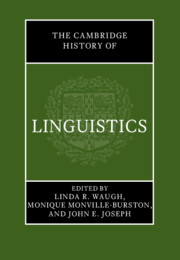Book contents
- The Cambridge History of Linguistics
- The Cambridge History of Linguistics
- Copyright page
- Dedication
- Contents
- Figures
- Tables
- Contributors
- Preface
- Acknowledgments
- Abbreviations, Acronyms, Special Symbols, and Other Conventions
- Introduction
- Part I Ancient, Classical, and Medieval Periods
- Part II Renaissance to Late Nineteenth Century
- Part III Late Nineteenth-through Twentieth-Century Linguistics
- Part IIIA Late Nineteenth Century through the 1950s: Synchrony, Autonomy, and Structuralism
- 13 Move to Synchrony: Late Nineteenth to Early Twentieth Century
- 14 Structuralism in Europe
- 15 British Linguistics
- 16 American Linguistics to 1960: Science, Data, Method
- Part IIIB 1960–2000: Formalism, Cognitivism, Language Use and Function, Interdisciplinarity
- References
- Index
16 - American Linguistics to 1960: Science, Data, Method
from Part IIIA - Late Nineteenth Century through the 1950s: Synchrony, Autonomy, and Structuralism
Published online by Cambridge University Press: 20 July 2023
- The Cambridge History of Linguistics
- The Cambridge History of Linguistics
- Copyright page
- Dedication
- Contents
- Figures
- Tables
- Contributors
- Preface
- Acknowledgments
- Abbreviations, Acronyms, Special Symbols, and Other Conventions
- Introduction
- Part I Ancient, Classical, and Medieval Periods
- Part II Renaissance to Late Nineteenth Century
- Part III Late Nineteenth-through Twentieth-Century Linguistics
- Part IIIA Late Nineteenth Century through the 1950s: Synchrony, Autonomy, and Structuralism
- 13 Move to Synchrony: Late Nineteenth to Early Twentieth Century
- 14 Structuralism in Europe
- 15 British Linguistics
- 16 American Linguistics to 1960: Science, Data, Method
- Part IIIB 1960–2000: Formalism, Cognitivism, Language Use and Function, Interdisciplinarity
- References
- Index
Summary
This chapter chronicles the beginnings of American (anthropological) linguistics: in the ‘Introduction’ to his Handbook, Boas provided a framework for analyzing each language in its own terms, and in Language, Sapir set out a broad view of language, culture, psychology, etc.
In the 1930s linguistics developed as a science (Whitney) that favored well-defined methods of analysis of empirical data. Bloomfield provided a set of postulates for autonomous, descriptive linguistics and published his well-regarded Language. In the 1940s, the (post-)Bloomfieldians emphasized distribution in phonemic analysis; later they studied morphophonemics, with debates about item-and-arrangement vs. item-and-process (Hockett), and linguists’ descriptions as ‘fact’ or ‘fiction’ (Swadesh). For syntax, they favored hierarchical ‘immediate constituents’ (Bloch) over slot-and-filler (Pike), while Harris (1951) eliminated meaning and searched for substitution classes. However, some said he had no regard for ‘reality.’ Others rejected Trager and Smith’s (1951) one phonemic analysis of all English dialects as too concerned with ‘methods.’
The 1950s also brought diversity: e.g., glottochronology/lexicostatistics (Swadesh); the Sapir-Whorf hypothesis; psycholinguistics (Carroll); semantic functions of intonation (Bolinger); connections with other disciplines (Pike).
In 1957, Harris discussed kernel sentences and grammatical transformations, and Chomsky published Syntactic Structures — which launched a new phase in American linguistics.
Keywords
- Type
- Chapter
- Information
- The Cambridge History of Linguistics , pp. 518 - 546Publisher: Cambridge University PressPrint publication year: 2023

